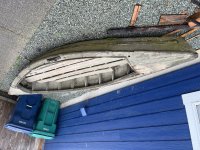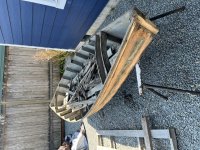I'm no wood working expert--I'm just a guy who re-glassed one old sculling boat-- so pay more attention to comments that follow from those who are actual experts.
Screws vs. nails: what did the original builder use. If nails, you'll probably need to get a clench nail.
Plywood vs planking: Do you want to maintain the historic integrity of the boat, or just get something you can use. Go with planking if you want to keep it historic. If you go with plywood, you may have trouble bending around the curves. If you go with planking--how were the original planks laid on? Overlapping? Butted against each other?
Glass with Epoxy: Definitely the way to go if you glass. Was the original boat glassed? Painted? Canvased? See above about maintaining historic.
Gaps between planks. If you do the wood working right, these should be very small--and will not matter much when you glass so long as you fill with thickened epoxy to get a smooth surface before you glass. Traditional wood boats that were not canvased or glassed probably would have used caulking between the planks--and not the caulking you use in your bathroom. If this is going to be a working boat that moves from wet to dry on car top or a trailer, this is probably not what you want to do. But it you do--https://www.youtube.com/watch?v=jM6R81SiKgA--and expect the boat to leak a little every time it's been out of the water to dry and you put it back in.
Filler for damaged areas. I'd suggest thickened epoxy. Basically, you will want to mix your resin and hardner, than add any of a variety of fillers that will thicken it so that can use it to fill low spots. Along joints, you will want to put in epoxy fillets to get a smooth surface that your glass cloth (if you go that route) can lay on smoothly.
For damaged areas or to fill small gaps, you can use thickened epoxy to build them up. Same idea as the fillets, except you'll be using a squeegee or putty knife to apply thin layers to bring the surface up to smooth rather than a fillet to turn a share angle into a curve. You'll need to sand these smooth, so use one of the fillers designed to be sanded. Lots of choices--and what you want for bonding or filleting is different from what you want for filling and fairing. Here's the layout from West System--many alternatives out there. I've used West System fillers in Raka rezin/hardener and other epoxies with no problems.
https://eu.westsystem.com/selection-guides/filler-selection-guide/





